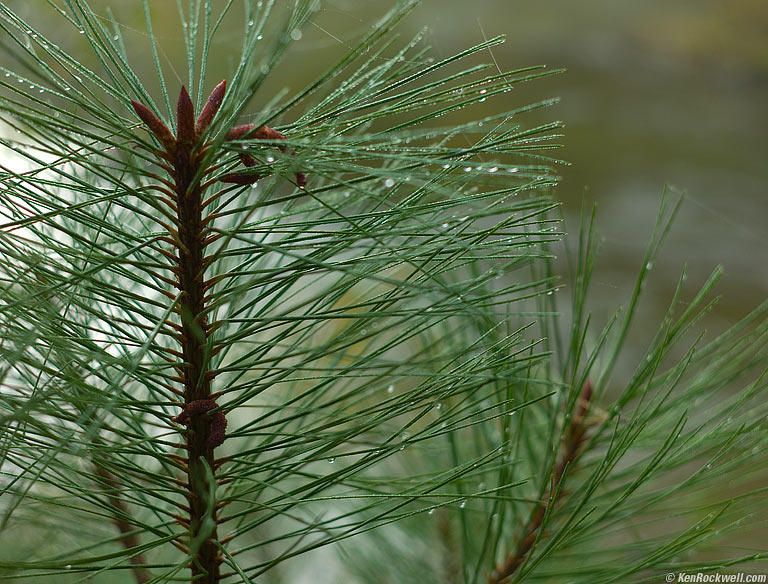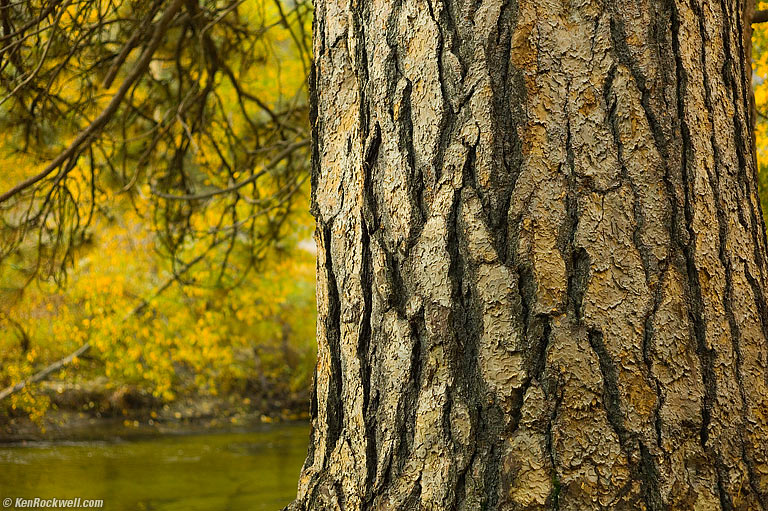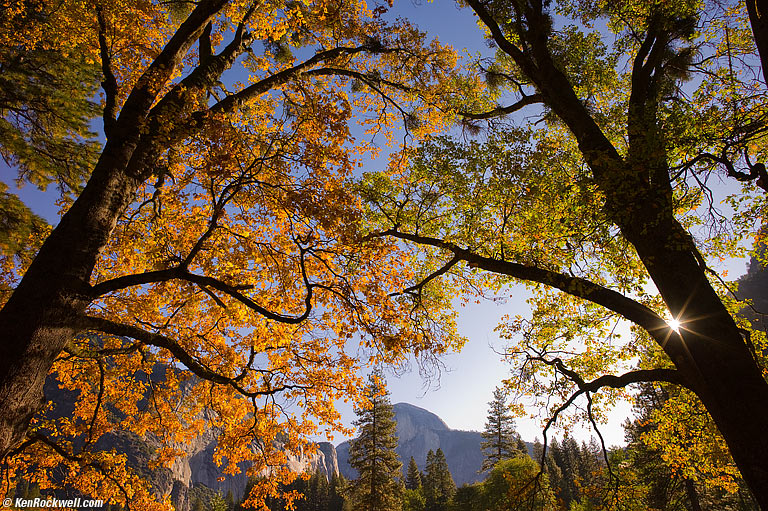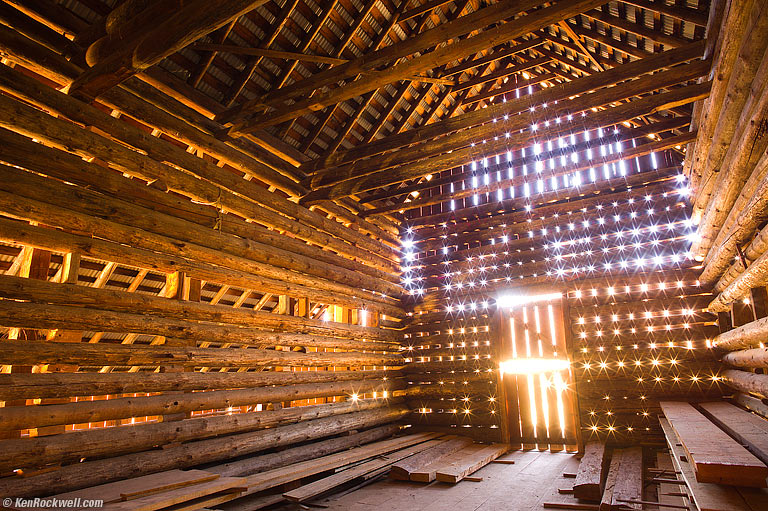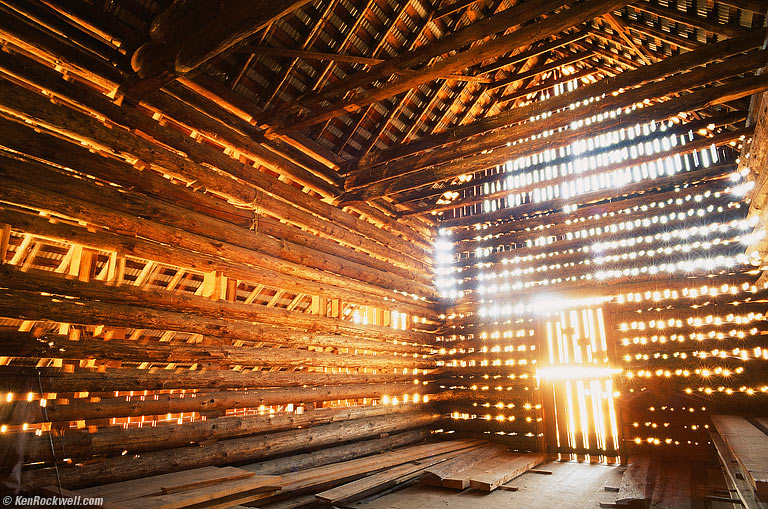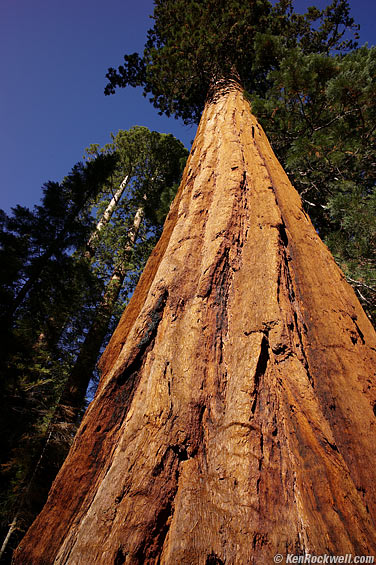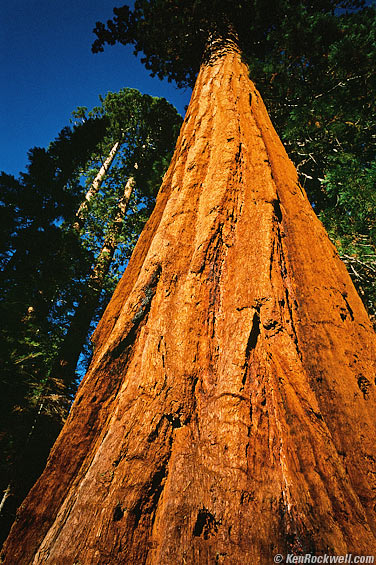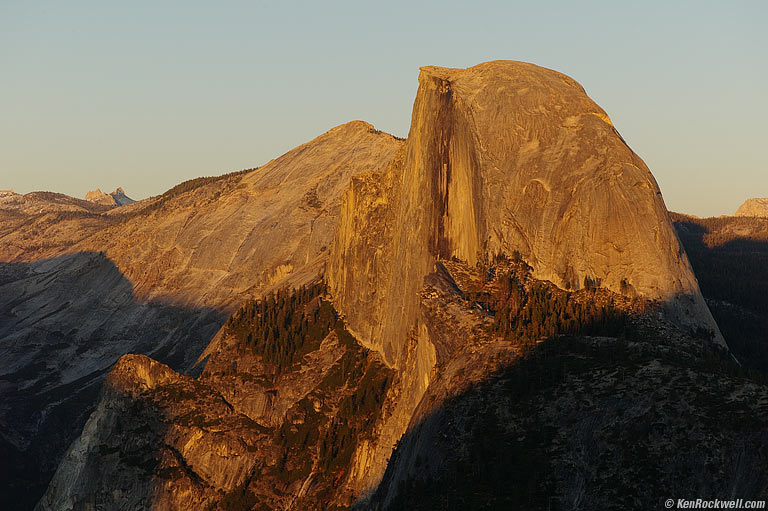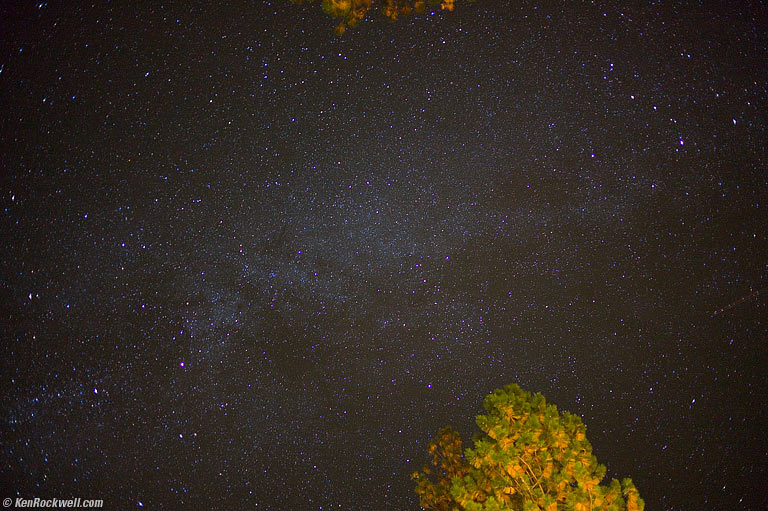Home Donate New Search Gallery How-To Books Links Workshops About Contact
Yosemite National Park,
Tuesday, 20 October 2009
© 2009 KenRockwell.com. All rights reserved.
Skip to: 18-19 20 21-22 23 24 25 October 2009
We got up and walked around the Merced River and the meadow behind the lodge.
Pine in Dew, Yosemite Valley near the Merced River, Yosemite National Park, 7:40 AM.
Full-resolution © JPG (4.5 MB) from DNG (18 MB).
Shot with a hand-held 2009 LEICA M9 and a 1970 LEICA 50mm f/2 SUMMICRON, Auto ISO 320, 1/125 probably at f/2, about 10,000 Kelvin WB.
The Mighty Pine and the Merced River, Yosemite National Park, 7:51 AM.
Full-resolution © JPG (8.2 MB) from DNG (18 MB).
Shot with a hand-held 2009 LEICA M9 and a 1970 LEICA 50mm f/2 SUMMICRON, Auto ISO 500, 1/125 probably at f/2.
Yosemite Valley, Yosemite National Park, Kalifornien, 9:11 AM.
Full-resolution © JPG (12 MB) from camera-original © DNG (18 MB).
Kamera-original © JPG (11 MB).
Snapped with a hand-held LEICA M9, a 1998 LEICA 21mm f/2.8 ELMARIT-M ASPH, ISO 160, f/8 at 1/180 second, Kelvin WB.
I shot this in DNG and opened it in PS CS4 ACR. I opened with as-shot WB, which was about 8,000K, and added about 30% saturation in ACR as I opened it. I added about 100% smart-sharpening at 0.2 pixel radius, and saved-as a JPG at quality = 10.
I can't get this quality from Nikon or Canon. They may make some cameras with more pixels, but they use softening filters so they don't deliver the real resolution, and their optics can't compete either. You don't have to twist my arm; this American-sensored camera weighs only a fraction as much as a DSLR, too!
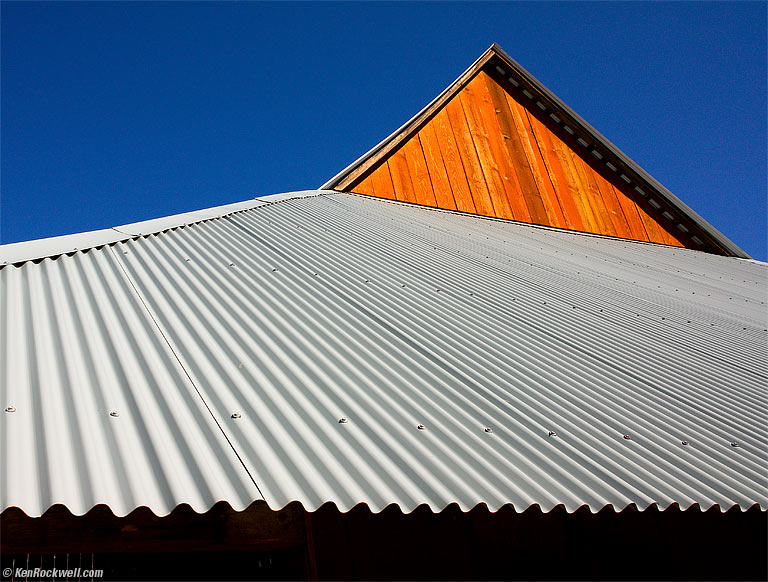
Der Kasten, Yosemite National Park, Kalifornien, 11:18 AM.
Snapped with a hand-held LEICA M9, a 1998 LEICA 21mm f/2.8 ELMARIT-M ASPH, ISO 160, 1/250 second, Kelvin WB.
Im Kasten, Yosemite National Park, Kalifornien, 11:18 AM.
Snapped with a 2009 LEICA M9, a 1998 LEICA 21mm f/2.8 ELMARIT-M ASPH, ISO 160, 24 seconds, Kelvin WB.
Full-resolution © JPG (7.9 MB) from camera-original © DNG (18 MB).
Kamera-original © JPG (11 MB).
Im Kasten, Yosemite National Park, Kalifornien.
Snapped with a 1955 LEICA M3 and a 1959 LEICA 21mm f/4 SUPER-ANGULON with Hoya 39mm 85C filter, Fuji Velvia 50 processed and scanned at NCPS, 4 minutes exposure at f/8, casual use of tripod.
Full-resolution © JPG (7.9 MB) from NCPS film scan.
The biggest difference in the film shot, besides the ghost with the tripod, the fact that I kicked my tripod halfway through the film shot, the contrast picked up in the inexpensive automated scan and of course the film grain, is that the 8-bladed diaphragm of the modern 21mm f/2.8 lens gives tacky 8-pointed sunstars, while the sublime 9-bladed diaphragm of the 1959 lens bestows the image with subtly magnificent 18-pointed sunstars.
Redwood, 3:42 PM. original JPG |
Really Redwood. original dark scan. |
Left photo: snapped with a hand-held 2009 LEICA M9, a 1998 LEICA 21mm f/2.8 ELMARIT-M ASPH, ISO 160, 1/125 second, 7,000 Kelvin WB. Image drawn from the camera-original JPG. (Sorry, DNG was turned off.)
Right photo: photographed with a hand-held 1955 LEICA M3 and a 1959 LEICA 21mm f/4 SUPER-ANGULON with B+W MRC 39mm 81A filter, Fuji Velvia 50 processed and scanned at NCPS, f/10 at 1/50. The 81A filter is how we set WB on film. I pulled-up the dark original scan with Curves in Photoshop. I have my lab scan dark so that the red channel doesn't clip with saturated colors. To get the film colors I did here, simply use a curve and drag one point to Output = 113 and Input = 51 in RGB mode (all the other film examples are as I got them back from the lab).
The Half Dome as seen from Glacier Point, Yosemite National Park, 6:06 PM. (digital capture.)
Snapped with a 2009 LEICA M9 and a 2003 LEICA 90mm f/2.8 ELMARIT-M, ISO 500, f/5.6, 1/500 second.
This is about how it looked that night: boring.
Here is the Camera-original JPG (5MB) and the Camera-original DNG (18MB).
Let's see if RealRAW looks any better.
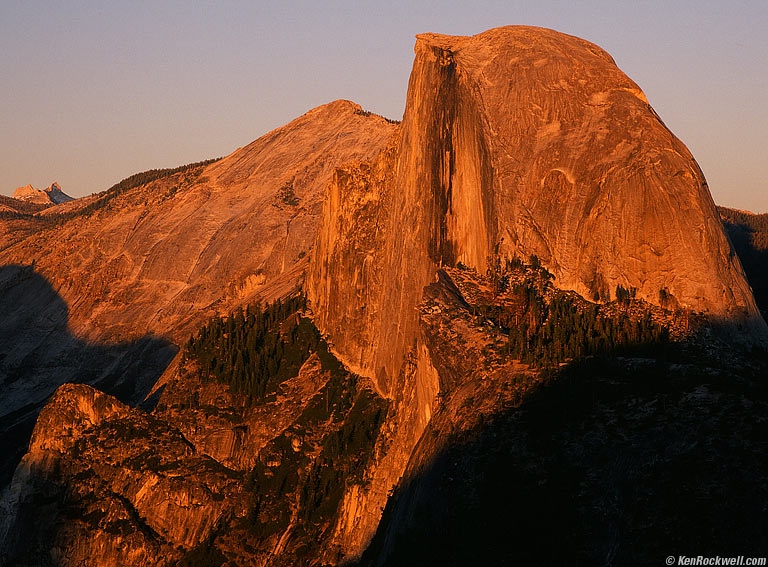
The Half Dome as seen from Glacier Point, Yosemite National Park, 6:03 PM. (actual photograph.)
Photographed with a 1955 LEICA M3 and a 1987 LEICA 90mm f/2.8 TELE-ELMARIT-M, with Hoya 39mm 85C filter, Fuji Velvia 50 processed and scanned at NCPS, f/9 at 1/25, casual use of tripod, slightly cropped. The 85C filter is how we set shade WB on film.
Original automated film scan (15MB).
AHA! This is why Velvia has been the professional standard of landscape and nature photography ever since its introduction in 1990. It makes photos look the way we want them, not the way they looked when we snapped the photo.
Let's see if we can jack around the Adobe Camera Raw settings in CS2 to approximate Velvia from the digital capture. We need to increase contrast and saturation, and crush the blacks.
For this next snap, I set CS2 ACR set to 7000K WB (as usual), +74 tint (adding a load of magenta), +0.5 exposure, 17 shadows (which turns the shadows black, like slide film), +50 bright, +32 contrast and +40 saturation:
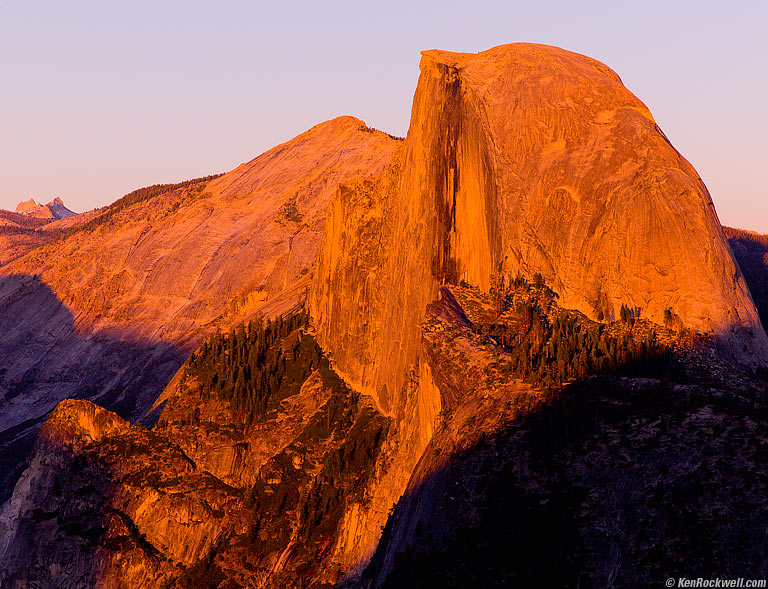
The Half Dome as seen from Glacier Point with jacked-up ACR settings, 6:06 PM.
This is from the same DNG as the first Leica M9 shot above.
This looks too much like candy.
The first natural digital shot looks natural, which is boring.
The second Velvia 50 shot looks as I want it.
The jacked-up ACR shot from the DNG looks wild, but I wouldn't want it hanging on my wall, at least not at night when I'm trying to sleep.
All this technical hocus-pocus forgets the obvious: I accidentally cut off the composition at the bottom, where the bright section mirrors the half dome. Whoops!
Let's see how each captures the magic magenta that can happen as the earth's shadow rises just after sunset.
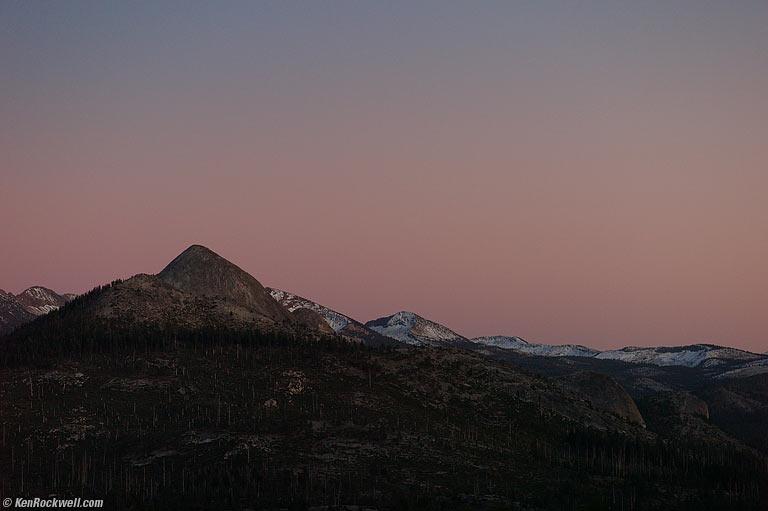
Afterglow, 6:22PM. (digital capture.)
Snapped with a hand-held 2009 LEICA M9 and a 2003 LEICA 90mm f/2.8 ELMARIT-M, ISO 1,000, 1/250 second.
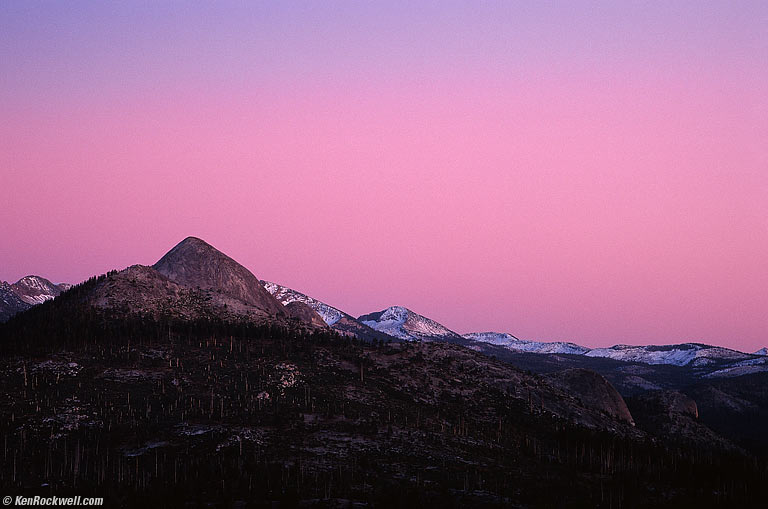
Afterglow, 6:22PM. (actual photograph.)
Photographed with a 1955 LEICA M3 and a 1987 LEICA 90mm f/2.8 TELE-ELMARIT-M, with Hoya 39mm 85C filter, Fuji Velvia 50 processed and scanned at NCPS, f/8 at 1/2, casual use of tripod. The 85C filter is how we set shade WB on film.
YES!!! Velvia 50 rules again.
Let's try jacking the DNG with the just about the same whacky settings in ACR to see what we can do. I used the same 7000K WB, +74 tint, 17 shadows, +50 brightness and +32 contrast, but set exposure to +1.65 and saturation to a whopping +77:
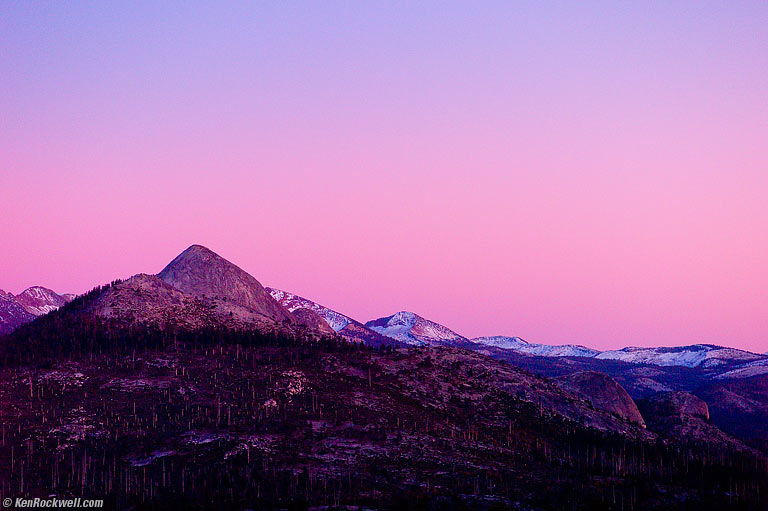
Afterglow, 6:22PM. (same base file as first dull version above.)
Aha, so we can get similar results if we jack around in ACR, but why jack around when Velvia 50 just gets us what we want without the fiddling? Notice that I have to use different fiddling for each digital image, and Heaven help you if you try these extreme settings with more ordinary subjects.
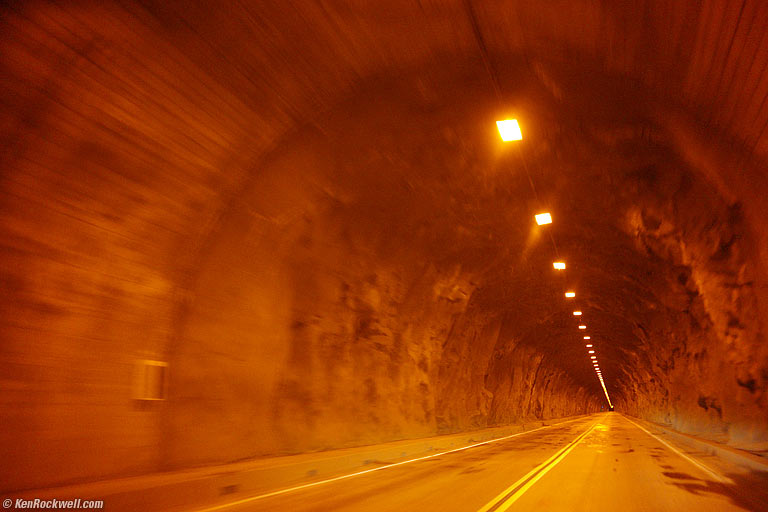
View of Tunnel View Tunnel, Yosemite National Park, 7:47 PM.
Shot with a hand-held 2009 LEICA M9 and a 2001 LEICA 35mm f/1.4 SUMMILUX-M ASPH, Auto ISO 1,600, 1/45 at f/1.4, Auto WB.
This is a trivial shot on a rangefinder camera; I don't know if I could have gotten my D3 to autofocus on the moving tunnel. It was easy with the Leica.
The Milky Way, Yosemite Lodge at the Falls Parking Lot, Yosemite National Park, 10:36 PM.
Shot with a 2009 LEICA M9 and a 2001 LEICA 35mm f/1.4 SUMMILUX-M ASPH, ISO 1,250, 24 seconds at f/1.4, Auto WB.
Full-resolution © JPG (6.4 MB) from Original 18MB © DNG.
You'll see some sky motion on the left, and a tiny bit of coma. If I made this shot with Nikon's newest 35mm f/1.4, it would be awful by comparison. Nikon's newest 35/1.4 is an old spherical design loaded with coma and spherical aberration.
Enough of these foolish long exposures; we need to get up at 6:45 AM tomorrow (a late start for us).
Next: 21 und 22 Oktober 2009
Home Donate New Search Gallery How-To Books Links Workshops About Contact
